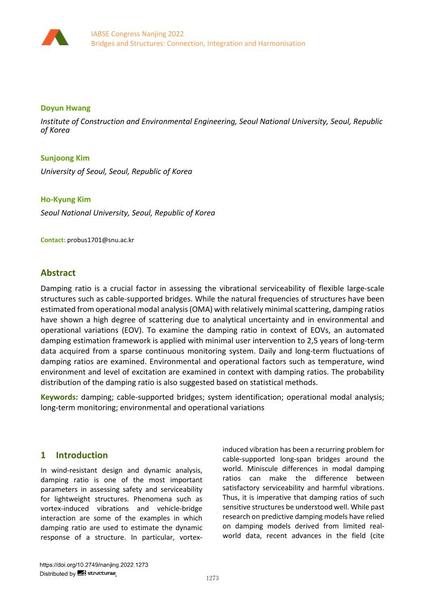Long-Term Damping Characteristics of a Cable-Stayed Bridge

|
|
|||||||||||
Bibliografische Angaben
| Autor(en): |
Doyun Hwang
(Institute of Construction and Environmental Engineering, Seoul National University, Seoul, Republic of Korea)
Sunjoong Kim (University of Seoul, Seoul, Republic of Korea) Ho-Kyung Kim |
||||
|---|---|---|---|---|---|
| Medium: | Tagungsbeitrag | ||||
| Sprache(n): | Englisch | ||||
| Tagung: | IABSE Congress: Bridges and Structures: Connection, Integration and Harmonisation, Nanjing, People's Republic of China, 21-23 September 2022 | ||||
| Veröffentlicht in: | IABSE Congress Nanjing 2022 | ||||
|
|||||
| Seite(n): | 1273-1279 | ||||
| Anzahl der Seiten (im PDF): | 7 | ||||
| DOI: | 10.2749/nanjing.2022.1273 | ||||
| Abstrakt: |
Damping ratio is a crucial factor in assessing the vibrational serviceability of flexible large-scale structures such as cable-supported bridges. While the natural frequencies of structures have been estimated from operational modal analysis (OMA) with relatively minimal scattering, damping ratios have shown a high degree of scattering due to analytical uncertainty and in environmental and operational variations (EOV). To examine the damping ratio in context of EOVs, an automated damping estimation framework is applied with minimal user intervention to 2,5 years of long-term data acquired from a sparse continuous monitoring system. Daily and long-term fluctuations of damping ratios are examined. Environmental and operational factors such as temperature, wind environment and level of excitation are examined in context with damping ratios. The probability distribution of the damping ratio is also suggested based on statistical methods. |
||||
| Stichwörter: |
Dämpfung
|
||||
| Copyright: | © 2022 International Association for Bridge and Structural Engineering (IABSE) | ||||
| Lizenz: | Die Urheberrechte (Copyright) für dieses Werk sind rechtlich geschützt. Es darf nicht ohne die Zustimmung des Autors/der Autorin oder Rechteinhabers/-in weiter benutzt werden. |
||||
